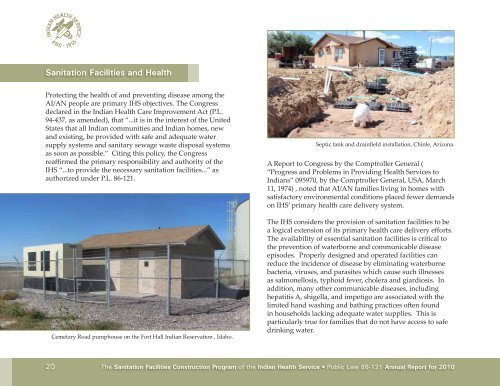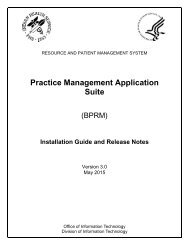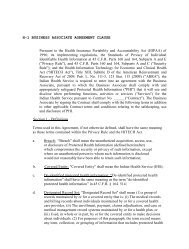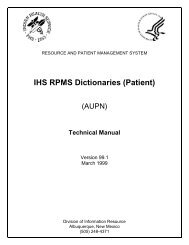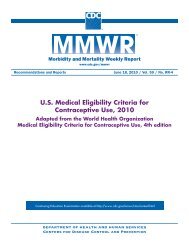Public Law 86-121 Annual Report for 2010 - Indian Health Service
Public Law 86-121 Annual Report for 2010 - Indian Health Service
Public Law 86-121 Annual Report for 2010 - Indian Health Service
You also want an ePaper? Increase the reach of your titles
YUMPU automatically turns print PDFs into web optimized ePapers that Google loves.
Sanitation Facilities and <strong>Health</strong><br />
Protecting the health of and preventing disease among the<br />
AI/AN people are primary IHS objectives. The Congress<br />
declared in the <strong>Indian</strong> <strong>Health</strong> Care Improvement Act (P.L.<br />
94-437, as amended), that “...it is in the interest of the United<br />
States that all <strong>Indian</strong> communities and <strong>Indian</strong> homes, new<br />
and existing, be provided with safe and adequate water<br />
supply systems and sanitary sewage waste disposal systems<br />
as soon as possible.” Citing this policy, the Congress<br />
reaffrmed the primary responsibility and authority of the<br />
IHS “...to provide the necessary sanitation facilities...” as<br />
authorized under P.L. <strong>86</strong>-<strong>121</strong>.<br />
Cemetary Road pumphouse on the Fort Hall <strong>Indian</strong> Reservation , Idaho.<br />
Septic tank and drainfield installation, Chinle, Arizona.<br />
A <strong>Report</strong> to Congress by the Comptroller General (<br />
“Progress and Problems in Providing <strong>Health</strong> <strong>Service</strong>s to<br />
<strong>Indian</strong>s” 095970, by the Comptroller General, USA, March<br />
11, 1974) , noted that AI/AN families living in homes with<br />
satisfactory environmental conditions placed fewer demands<br />
on IHS’ primary health care delivery system.<br />
The IHS considers the provision of sanitation facilities to be<br />
a logical extension of its primary health care delivery ef<strong>for</strong>ts.<br />
The availability of essential sanitation facilities is critical to<br />
the prevention of waterborne and communicable disease<br />
episodes. Properly designed and operated facilities can<br />
reduce the incidence of disease by eliminating waterborne<br />
bacteria, viruses, and parasites which cause such illnesses<br />
as salmonellosis, typhoid fever, cholera and giardiosis. In<br />
addition, many other communicable diseases, including<br />
hepatitis A, shigella, and impetigo are associated with the<br />
limited hand washing and bathing practices often found<br />
in households lacking adequate water supplies. This is<br />
particularly true <strong>for</strong> families that do not have access to safe<br />
drinking water.<br />
20<br />
The Sanitation Facilities Construction Program of the <strong>Indian</strong> <strong>Health</strong> <strong>Service</strong> • <strong>Public</strong> <strong>Law</strong> <strong>86</strong>-<strong>121</strong> <strong>Annual</strong> <strong>Report</strong> <strong>for</strong> <strong>2010</strong>


